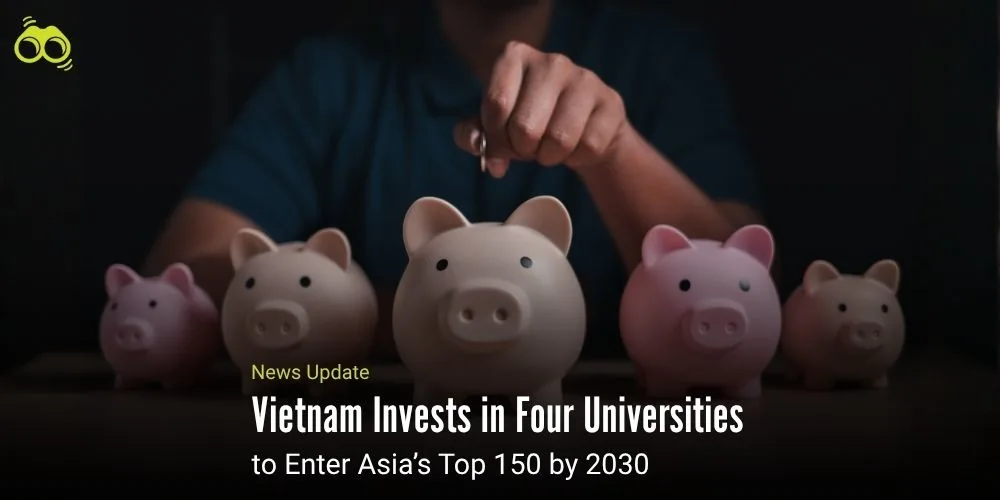Four Leading Institutions Positioned as Pillars of Vietnam’s Research and Innovation Ecosystem
Vietnam Channels Major Resources into University Innovation and Global Competitiveness
Vietnamese Universities are to get big investment under a national plan to place four institutions in Asia's Top 150 Universities by 2030. The development plan, published by the Central Steering Committee on Science, Technology, Innovation and Digital Transformation, places the institutions as national flagships of higher education and Research & Innovation Ecosystem. The regulation names Vietnam National University Hanoi, Vietnam National University Ho Chi Minh City, Hanoi University of Science and Technology, and the University of Danang as the major recipients of this strategic plan. These institutions have been charged with luring at least US$50 million of yearly research funding, initiating 50 innovative start-ups per annum, and incubating 10 successful enterprises worth at least US$200 million between 2026 and 2030.
To achieve these goals, radical reforms have been designed. At least 60% of science, engineering, and technology programs have to be taught through English Language Instruction in STEM Programs, with a high focus on creating Dual-Degree Partnerships with international institutions placed in the top 200. Furthermore, half of all academic courses need to be infused with Project-Based Learning & Internships or research orientation, with internships made a mandatory part of the curriculum. The plan also demands substantial Postgraduate & PhD Student Expansion. The postgraduate students are expected to make up 30% of total registration by 2030, with 40% of them taking on doctoral programs. To lure top-quality researchers, the tuition fees for PhD students will be exempted from the 2026–2027 academic year, and scholarships will be provided through teaching and research assistantships.
Doctoral students, in turn, will be required to spend at least 10 months overseas at top research universities or research institutes. Faculty members, on their part, should be provided with opportunities every five to seven years to spend a year on placements at top-class laboratories or R&D facilities in top companies. The four universities are required to submit comprehensive action plans by November with the strategies they intend to use in ascending regional rankings, as well as suggest mega infrastructural projects for strategic industries. The proposals must balance national priorities with institutional ambition.
The Vietnamese government has involved ministries, state enterprises, and local governments in Hanoi, Da Nang, and Ho Chi Minh City in the implementation of the program. The model envisioned is that of a "three-house model," linking universities and industries and the government, thus enhancing Vietnam's startup and innovation economy and its position on the world academic stage. This is indeed a new impetus in Vietnam's transitional policy addressing higher education, placing Vietnamese Universities at the very frontline of national development and world competitiveness.
Editors' Note
Vietnam's decision to invest heavily in its four flagship universities marks a turning point in the higher education strategy of the country. By identifying Vietnam National University Hanoi, Vietnam National University Ho Chi Minh City, Hanoi University of Science and Technology, and University of Danang as national priorities, the government has signalled its sincere intention to promote the capacity of its institutions and their global competitiveness. The ambition enshrined in the directive sees the institutions placed among the 150 best in Asia by the year 2030, far from an empty aspiration; it essentially embodies a long-standing national commitment toward establishing a high-functioning research and innovation ecosystem that will catalyse long-term economic and intellectual growth. The candid roadmap before these selected Vietnamese universities is at once both comprehensive and intimidating within its requirements. The roadmap requires substantial funds for research activities yearly, scores of startups to be created, and high-value businesses to be set up under major academic reforms.
The reforms toward English language instruction in STEM programmes, launching dual degrees with the best global institutions, and requiring project-based learning and internships indicate a practical understanding of international benchmarks. In tandem, fostering postgraduate education and increasing the number of PhD students, providing tuition waivers, and facilitating doctoral candidates' overseas placements demonstrates a tactical talent development and retention strategy. Incredibly, it differs from other interventions by using an integrated support model: by connecting several ministries with state agencies and city governments, Vietnam constructs, through the operation of a '3 Player Model', families for universities, industry, and public policies. This initiative is crucial for developing infrastructure, fostering partnerships, and building cultural capital to drive widespread innovation. If executed with discipline and a long-term vision, this plan could redefine the regional and global role of Vietnamese universities, transforming them from mere knowledge factories into enterprises and key players in nation-building. More than just a quest for higher rankings, this is a strategic blueprint for institutional transformation. Vietnam is making a significant investment in its intellectual future, characterised by integrity, ambition, and unwavering strategic commitment.
Skoobuzz believes that this directive reflects Vietnam’s resolve to shape a globally competitive academic landscape. It is a decisive step towards embedding innovation at the heart of national development.
FAQs
1. Which Vietnamese universities are targeted for development under the new directive?
The government has named four flagship institutions: Vietnam National University Hanoi, Vietnam National University Ho Chi Minh City, Hanoi University of Science and Technology, and the University of Danang. These universities will receive major resources to elevate their standing in Asia’s Top 150 Universities by 2030.
2. What resources are being invested in Vietnam’s top universities to reach Asia’s Top 150 by 2030?
Each university is expected to attract at least US$50 million annually for research, supported by large-scale infrastructure projects and coordinated backing from ministries, state-owned enterprises, and municipal governments in Hanoi, Da Nang, and Ho Chi Minh City.
3. What goals has Vietnam set for its universities in terms of research, startups, and English-taught programmes?
The directive outlines ambitious targets: launching 50 innovative startups per year, developing 10 successful enterprises worth US$200 million between 2026 and 2030, and ensuring that 60% of science, engineering, and technology programmes are taught in English.
4. How much funding do these universities need to attract annually for research?
Each of the four Vietnamese universities must secure a minimum of US$50 million per year in research funding to meet the directive’s benchmarks and support their innovation and development goals.
5. What changes are required in doctoral training and faculty exchange under Vietnam’s plan?
Starting in 2026–2027, all PhD candidates will receive tuition waivers and scholarships through teaching and research assistantships. Doctoral students must spend at least 10 months abroad at elite institutions, while faculty members are expected to undertake one-year placements at world-class laboratories or R&D centres every 5–7 years.
6. How will postgraduate and PhD student growth be supported?
By 2030, 30% of all students at the targeted universities must be postgraduates, with 40% of those pursuing PhDs. The plan includes financial support, international placements, and enhanced academic pathways to encourage advanced study.
7. What role does English language instruction play in the development plan?
The directive mandates that at least 60% of STEM programmes be delivered in English, aligning Vietnamese universities with global standards and improving accessibility for international collaboration and dual-degree partnerships.
8. How will dual-degree partnerships enhance Vietnamese universities?
Universities are encouraged to form dual-degree partnerships with institutions ranked in the global top 200. These collaborations aim to improve academic quality, expand international networks, and support student mobility.
9. What is the significance of project-based learning and internships in the new curriculum?
Half of all courses must include practical training, project-based learning, or research components. Internships will be compulsory, ensuring students gain real-world experience and industry-relevant skills.
10. How does the directive support Vietnam’s broader research and innovation ecosystem?
The initiative promotes a “three-house model” linking universities, businesses, and government. This integrated approach is designed to strengthen Vietnam’s startup ecosystem, foster innovation, and position higher education as a driver of national development.














0 Comments (Please Login To Continue)